Nazi Catcher In The Rye - Part Four - Why Fund The New IG Farben In Ukraine?
Funding Farben-Bilder (Webb's Nickname For Bilderberg Conference) - Why? Has It Ever Been Done Before?
In the Summer of 2020, author George Webb visited every one of the five Normandy invasion beaches and most of the French towns involved in the breakout from the beachheads. In this series, George Webb explores why we are now funding the very same Nazi elements in Ukraine we fought in World War II.
As many in our research community already know, I have likened the modern-day Bilderberg Group to the public relations arm of the reconstituted group of companies that were part of the old Nazi conglomerate of Holocaust medical experiments and death camp fame, IG Farben.
Detailed summary of the article
George Webb opens by recalling his 2020 tour of the five Normandy-invasion beaches to underscore the irony that the United States is again bankrolling forces he regards as ideological heirs of the Nazis—this time in Ukraine.
Webb argues that today’s “fear-pandemic” business model is run by what he calls a “re-constituted IG Farben cartel,” embodied by Bayer, Sanofi (Hoechst), and BASF, with looser historical links to GlaxoSmithKline, Pfizer, Eli Lilly, Merck, and Johnson & Johnson. These firms, he says, profit whenever global elites—meeting under the Bilderberg banner—stoke biological or psychological crises to unlock huge tranches of U.S. government funding.
Webb traces the strategy to Henry Kissinger, Klaus Schwab, Schwab’s father Eugen, and Bilderberg founder Prince Bernhard, all of whom he depicts as using “FarbenBilder” (his label for an IG Farben-style propaganda engine) to manufacture threat narratives.
In Webb’s telling, Ukrainian oligarch Igor Kolomoisky plays the modern IG Farben quarterback, managing biolab stockpiles whose very existence keeps Western aid flowing.
Webb links the operational side of this alleged scheme to Fort Belvoir’s “Task Force Orange” (the Army’s Intelligence Support Activity) and to the World-War-II era Gehlen Organization that migrated to the United States under the “Fort Hunt Agreement.”
Webb’s late research partner—an ex-police officer nicknamed “Task Force”—believed these same actors would one day unleash bio-agents inside America to impose domestic lockdowns.
The article closes by likening every Bilderberg meeting to a polished sales pitch: wine, food, “OCONUS LURES” for blackmail, and a pre-cooked story that funnels Congressional appropriations (he cites the recent $90 billion Ukraine package) into a Swiss “pile of money.” Webb promises that the next installment will detail how Klaus Schwab’s family allegedly laundered IG Farben war profits.
Profiles of people
George Webb is an American investigative writer best known for self-published series that link intelligence services, pandemics, and organized crime. In the draft, he acts as narrator, drawing parallels between World War II and the present Ukraine conflict. Webb frames the Bilderberg Group as a public-relations front for a resurrected IG Farben cartel. His claims are controversial and largely unsupported by mainstream historians or primary-source documentation.
Henry Kissinger (1923 – 2023) was a U.S. National-Security Adviser and Secretary of State whose realpolitik approach shaped Cold-War diplomacy. Late in life he warned in a Wall Street Journal op-ed that the coronavirus pandemic would “forever alter the world order,” a sentiment Webb cites to show Kissinger’s influence on “fear-pandemic” narratives. Kissinger remained an adviser to corporate and political leaders until his death at age 100. Critics and admirers alike note his enduring global reach.
Klaus Schwab founded the World Economic Forum in 1971 and served as its executive chairman until 2025. Webb portrays him as a modern exponent of IG Farben-style crisis profiteering. Schwab is widely known for convening annual Davos meetings of political and business elites. Allegations that he pursues an authoritarian “Great Reset” are common in conspiratorial literature but remain unproven.
Eugen Schwab managed the Swiss engineering firm Escher Wyss’s Ravensburg plant during the Nazi era and is Klaus Schwab’s father. Online rumors claim he was a high-ranking Nazi, but fact-checkers find no evidence he held party office, noting only that the factory supplied the German war effort. The disinformation surrounding him illustrates how tenuous historical facts can fuel modern conspiracy theories. Webb hints that Eugen helped launder IG Farben money through Swiss channels.
Prince Bernhard of the Netherlands (1911 – 2004) joined the Nazi Party in 1933, married Queen Juliana, and co-founded the Bilderberg Group in 1954. Declassified files reveal he took $1.1 million in Lockheed bribes while lobbying NATO weapons purchases, forcing his resignation from public posts. Webb casts Bernhard as the archetypal “FarbenBilder” operative who merged corporate lobbying, elite networking, and psychological operations. Bernhard’s mixed legacy includes both conservation projects and enduring corruption scandals.
Igor Kolomoisky is a Ukrainian-Israeli billionaire who co-founded PrivatBank and briefly served as the governor of Dnipropetrovsk Oblast in 2014. U.S. and Ukrainian authorities have investigated him for alleged fraud and money-laundering, though he denies wrongdoing. Webb alleges Kolomoisky runs Ukrainian biolabs on behalf of a global “fear-pandemic” cartel, a claim unsubstantiated by public evidence. Kolomoisky’s media holdings and patronage of the Azov Battalion keep him at the center of Ukraine’s political economy.
Reinhard Gehlen headed Nazi Germany’s military-intelligence section for the Eastern Front, surrendered to U.S. forces in 1945, and negotiated the secret Fort Hunt Agreement to continue spying—this time for Washington. His “Gehlen Org” became the CIA’s main eyes in Eastern Europe during the early Cold War. Webb cites Gehlen as the originator of U.S. psychological-warfare techniques later housed at Fort Belvoir. Historians still debate whether Gehlen’s post-war reports were accurate or self-serving.
“Task Force” was Webb’s late research partner, an ex-police officer who believed U.S. special-operations units would eventually deploy bio-agents domestically. Webb credits her with first focusing his investigations on Task Force Orange and Fort Belvoir. She supposedly maintained contacts inside JSOC who warned of looming biological false-flag attacks. Her sudden death in 2018 is an unresolved point of tension in Webb’s narrative.
Profiles of organizations
IG Farben was once the world’s largest chemical trust, notorious for producing Zyklon B and profiting from Auschwitz slave labor. After the war the Allies split the conglomerate into Bayer, Hoechst (now part of Sanofi), and BASF, but the holding company technically remained in liquidation until 2012. Webb argues that its scientific networks quietly rebuilt under new names and now dominate Big Pharma. Scholars agree on IG Farben’s wartime crimes but reject claims of a seamless corporate conspiracy lasting into the 21st century.
Bayer AG was founded in 1863 in Wuppertal, Germany, and became famous for inventing aspirin. It re-emerged from IG Farben in 1951 and today markets everything from pharmaceuticals to agricultural chemicals. Critics fault its 2018 acquisition of Monsanto for legal liabilities over glyphosate. Webb lists Bayer among the “Big Three” heirs benefiting from pandemic fear.
Sanofi (earlier Sanofi-Aventis/Hoechst) descends from Hoechst AG, one of the IG Farben successor firms, and merged with France’s Rhône-Poulenc to form Aventis in 1999 before adopting the Sanofi name. It ranks among the world’s top vaccine manufacturers. The company’s Hoechst lineage underpins Webb’s thesis of Nazi scientific continuity. Mainstream corporate histories make no such ideological connection.
BASF began in 1865 as Badische Anilin- & Soda-Fabrik and pioneered synthetic dyes and the Haber-Bosch ammonia process. Reconstituted in 1952 after the IG Farben breakup, it is now the globe’s largest chemical producer. Environmentalists routinely scrutinize its carbon footprint and plastic-additive products. Webb slots BASF into his “Big Three” pandemic-profit bloc.
GlaxoSmithKline (GSK) formed in 2000 from the merger of Glaxo Wellcome and SmithKline Beecham, tracing roots to 18th-century London apothecaries. It specializes in vaccines, respiratory drugs, and consumer health brands. Webb treats GSK as a peripheral IG Farben descendant because ex-Farben scientists allegedly migrated there. No public record supports a direct corporate lineage.
Pfizer Inc. was established in 1849 in Brooklyn by German-American cousins Charles Pfizer and Charles Erhart, growing into a pharmaceutical powerhouse noted for penicillin, Lipitor, and the first FDA-approved mRNA COVID-19 vaccine. The company today operates in more than 150 countries. Webb claims IG Farben alumni influenced Pfizer’s post-war research culture, a link lacking archival proof. Historians instead view Pfizer’s rise as driven by U.S. wartime penicillin contracts.
Eli Lilly and Company was founded in Indianapolis in 1876 by Civil War veteran Colonel Eli Lilly, introducing gelatin-coated pills and mass-producing insulin in 1923. It now markets psychiatric, oncology, and diabetes therapies. Webb lists Lilly among firms loosely tied to IG Farben émigrés. The company’s official history records no such connection.
Merck & Co. originated as the U.S. arm of German Merck KGaA in 1891, becoming independent during World War I and famous for developing the first measles vaccine. Today it focuses on oncology blockbuster Keytruda and vaccines like Gardasil. Webb tags Merck as another heir to Nazi-era science. Documentary evidence shows only that Merck competed with, not descended from, IG Farben.
Johnson & Johnson has produced sterile surgical supplies since its founding in 1886 and later diversified into consumer brands and medical devices. Recent lawsuits over talc and opioids have tarnished its reputation. Webb argues J&J profits from pandemic cycles orchestrated by Bilderberg alumni. The company’s public disclosures do not corroborate coordinated crisis profiteering.
Bilderberg Group is an annual, invitation-only forum launched in 1954 at Hotel de Bilderberg in the Netherlands to foster Atlantic-world dialogue. Its secrecy fuels speculation, but agendas usually center on economics, security, and technology. Prince Bernhard chaired the first meetings until scandal sidelined him in 1976. Webb recasts the conference as a “FarbenBilder” marketing arm for fear-driven bio-capitalism.
NATO (North Atlantic Treaty Organization) is a 31-member military alliance founded in 1949 for collective defense. Prince Bernhard’s Lockheed bribery drama sparked concerns about corruption undermining NATO procurement in the 1970s. Webb expands that worry into a claim of Nazi-run psychological warfare cells inside NATO. Historians document bribery but not a continuing Farben-Nazi command structure.
United States Army is the land-warfare branch of the U.S. armed forces, established in 1775 and now headquartered at the Pentagon. Webb targets two Army posts—Fort Belvoir and Fort Detrick—as hubs for legacy Nazi bio-research. Official Army sources present these bases as engineering, logistics, and infectious-disease centers. No declassified record links them to covert pandemic profiteering.
Fort Belvoir began as engineer-training Camp Humphreys in 1917 and today hosts multiple commands plus the National Museum of the U.S. Army. A climate-controlled warehouse on base indeed stores captured Nazi art. Webb contends Fort Belvoir also houses Task Force Orange and hidden IG Farben archives. The base publicly identifies no such mission.
Fort Detrick in Maryland has handled high-containment biodefense research since World War II and is home to USAMRIID. Its labs study countermeasures for Ebola, anthrax, and other threats. Webb treats Fort Detrick as the eastern node of a Farben-derived biowarfare enterprise. Public records confirm past offensive programs (ended in 1969) but not current illegal activity.
Task Force Orange is the colloquial name for the Intelligence Support Activity, a clandestine U.S. Army unit specializing in signals and human intelligence for special operations. Within JSOC it conducts “special reconnaissance” and data fusion. Webb alleges the group expanded into bio-agent logistics, echoing his partner’s claims. The unit’s real-world mandate remains classified but documented roles involve intelligence, not pathogen deployment.
Joint Special Operations Command (JSOC) oversees elite units such as SEAL Team 6 and Delta Force, providing unified command for high-risk missions. It integrates Task Force Orange for intelligence and targeting. Webb portrays JSOC contacts as sources for warnings about domestic bio-attacks. Official histories describe JSOC’s focus as counterterrorism raids rather than psychological-biological warfare.
U.S. Congress is the bicameral federal legislature empowered by Article I of the Constitution to authorize spending bills. Webb argues that carefully crafted “FarbenBilder” narratives pressure Congress into approving massive aid and vaccine budgets, citing the recent $90 billion Ukraine appropriation as an example. Congressional appropriations are public records, but no evidence shows lawmakers knowingly funding Nazi-linked conspiracies. The institution’s checks and balances are designed to scrutinize, debate, and amend such spending before passage.
Introduction
The Big Three of IG Farben fame that are now direct beneficiaries of the CoronaVirus fear pandemic are Bayer, Sanofi Adventis (Hoechst), and BASF. These companies were directly part of the IG Farben cartel in Nazi Germany. More tenuous links can be drawn to GlaxoSmithKline, Pfizer, Eli Lilly, Merck, and Johnson and Johnson through IG Farben scientists that were secreted out of Germany and Poland at the end of World War II.
Those who have been following the SubStack here know that I have traced all the fear pandemics to Henry Kissinger, Klaus Schwab, his father, and the IG Farben exec turned Dutch Crown Prince, Prince Bernhard, founder of Bilderberg Group.
Prince Bernhard basically ran a Nazi spy ring that had infiltrated NATO, and was taking bribes from weapons manufacturers for the first 22 years of Bilderberg.
My basic premise here is that nothing has changed with Bilderberg, not even the name. The only real change is the names of the Ukrainian businessman that are really Swiss oligarchs that are handling their weapons deals at a commission
I have accused Ukrainian Billionaire Igor Kolomoisky of being a modern-day IG Farben man in Ukraine, managing biological agent stores there on behalf of an international fear pandemic-creating machine.
I have called this process of creating fear pandemics in order to get billions from the US Government “A Clockwork Orange”, referring to the fear-generating group it comes from called Task Force Orange in Fort Belvoir, Virginia. This fear-generating group at Ft. Belvoir in Virginia goes all the way back to 1947 when Nazi master fear generator Reinhard Gehlen brought his psychological operations fear generators there as a result of the Ft. Hunt Agreement. I have done numerous stories about the Nazi art stored there.
I have been going to Ft. Belvoir doing stories since 2017, and many trips were with an ex-cop who was convinced the next fear pandemic, the next “Clockwork Orange”, would come from the IG Farben holdovers at Fort Belvoir called Task Group Orange. Task Force, unfortunately, died unexpectedly in 2018.
My ex-cop research partner talked so much about Task Force Orange so often that I gave her the nickname “Task Force” (and for her formidable investigative prowess). “Task Force” was convinced bioagents had been used by Task Force Orange from Ft. Belvoir in the past.
Task Force said she had Joint Special Operations (JSOC) contacts that assured her of this. and Task Force felt very strongly someday bioagents would be used in America to lock down the population.
I have done numerous videos and live streams since 2017 from the two key US Army forts where the IG Farben bioagent scientists landed after World War II - Ft Detrick and Ft. Belvoir, both before and after Task Force’s untimely death.
So that brings me back to what I believe a Farben Bilder is. A FarbenBilder is a fear pandemic created by the US Army or NATO Psychological operations to get billions of dollars from the US Congress. Think of a FarbenBilder as the old IG Farben guys building a pile of money in Switzerland from the fear of pandemics they create.
And yes, you guessed it, the Prince of Orange that started Bilderberg was an executive for an IG Farber subsidiary called - wait for it - Farben Bilder. And yes, this Prince of Orange was a Nazi SS man who did Psychological Operations for who? IG Farben.
The founder of Bilderberg and host for the first 24 years, Prince Bernhard, Prince of Orange, never really changed jobs from his executive position at Farben Bilden - creating false narratives to get money from the US Congress. In Prince Bernhard’s time, it was continual NATO money from the US Congress, even after the fall of the Soviet Union.
The Bilderberg meetings, the subject of so many conspiracy theories, are actually just a very tried and true method of getting a false narrative out - Building a FarbenBilder. Invite elites, have great food, and “OCONUS LURES” (beautiful women spies who bed their targets for inside information or blackmail) for blackmail, and then spin false narratives. And that’s how you create a FarbenBilder. And the US Congress just shelled out $90 Billion for the latest FarbenBilder in Ukraine.
I am at my SubStack limit, so in the next SubStack I will talk about how Klaus Schwab’s family laundered the money for the IG Farben German war contractors.
Here are the related documents.


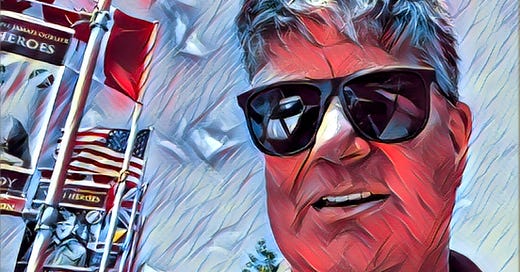



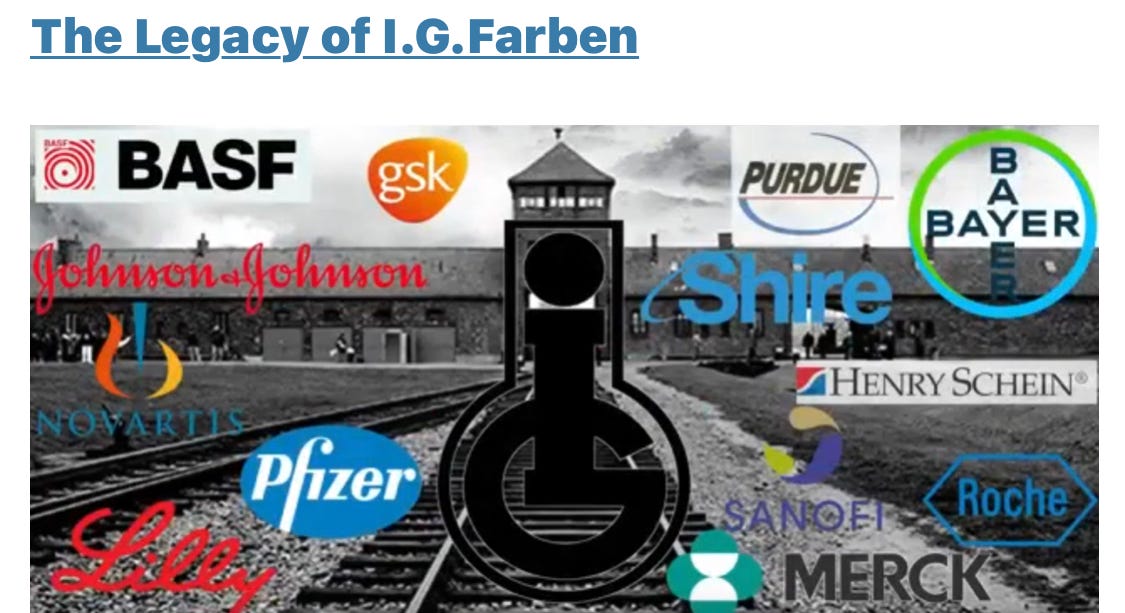
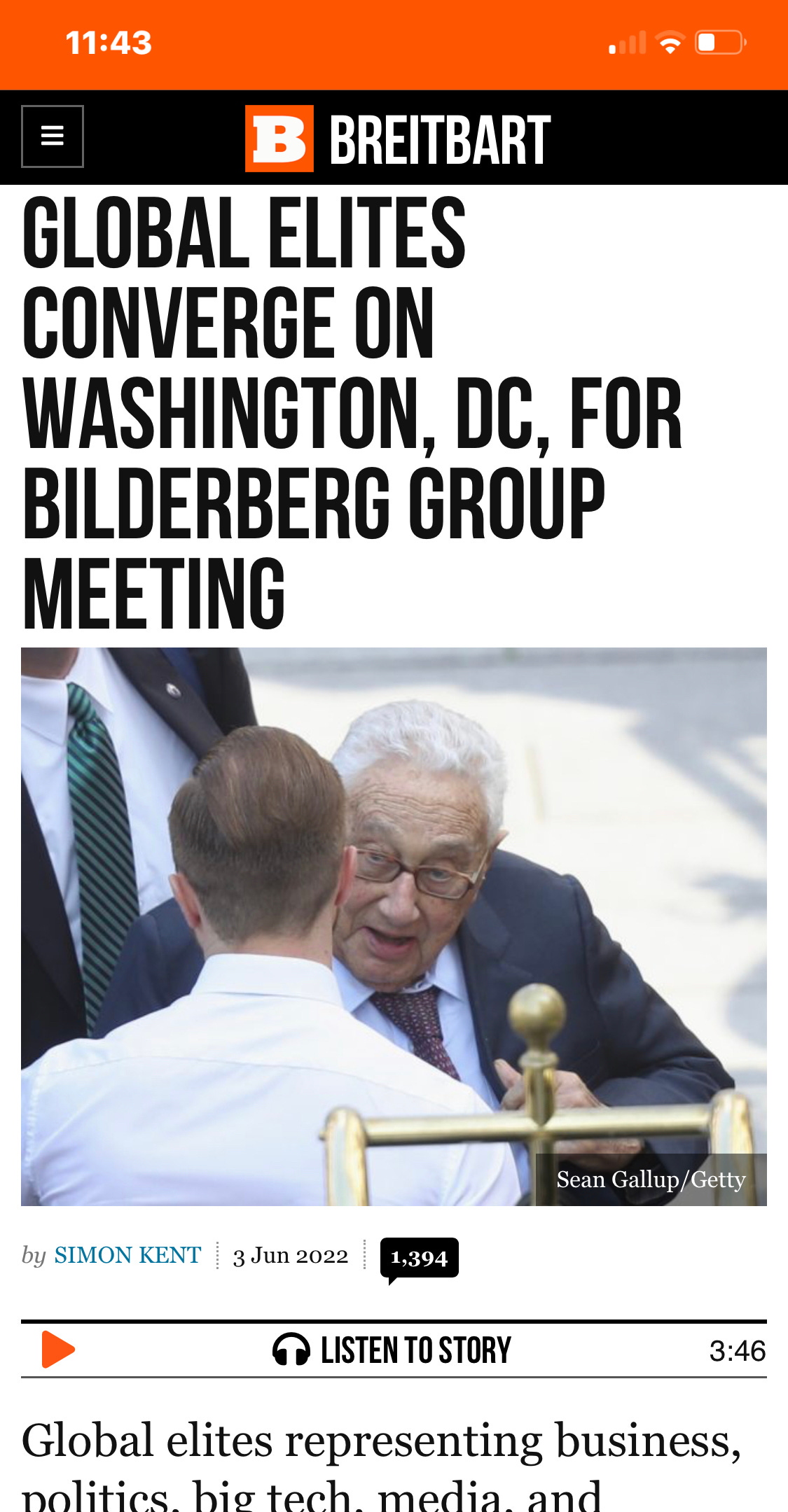
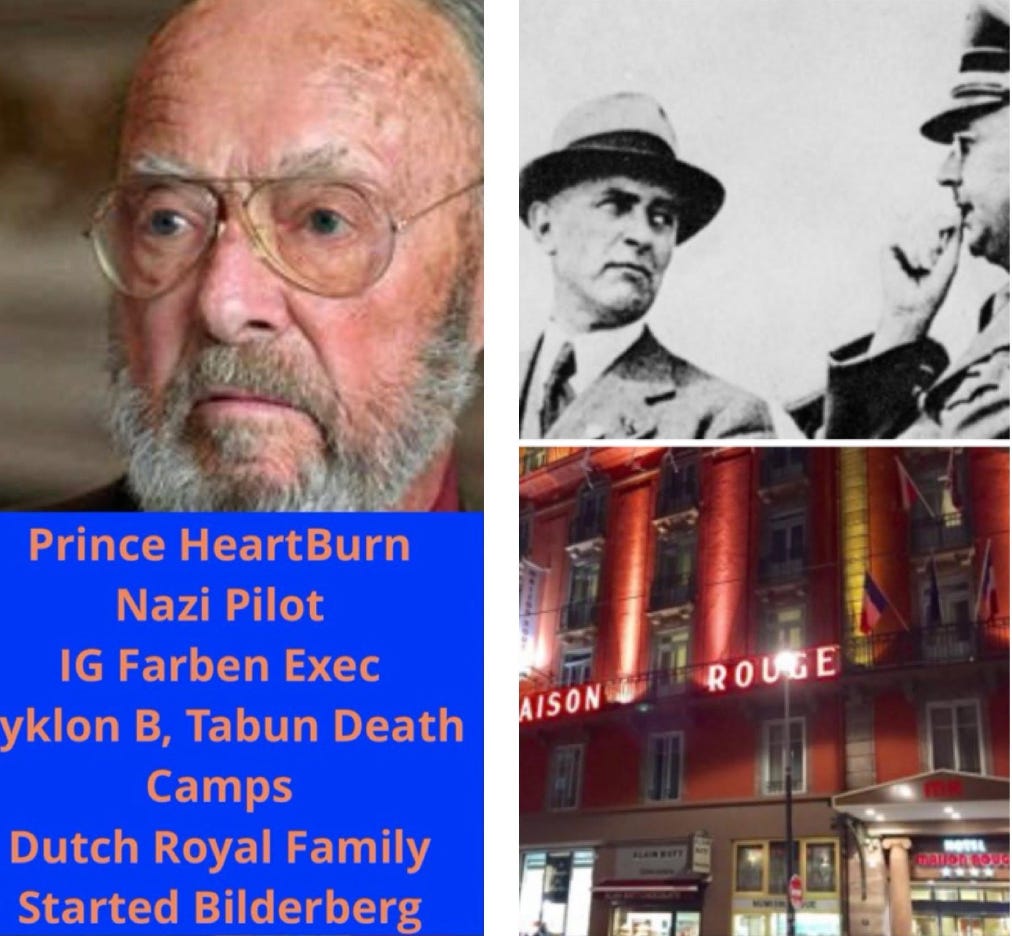



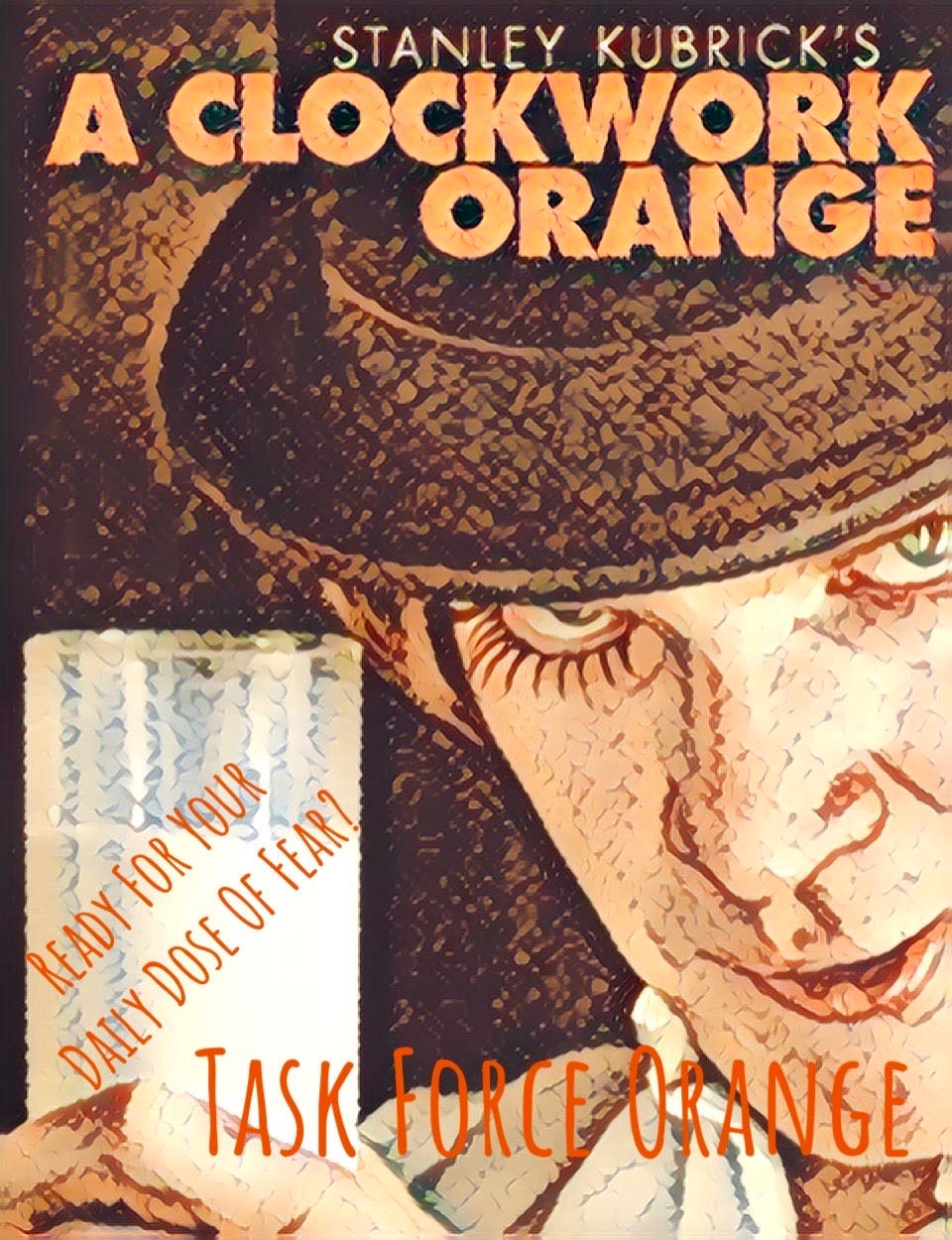


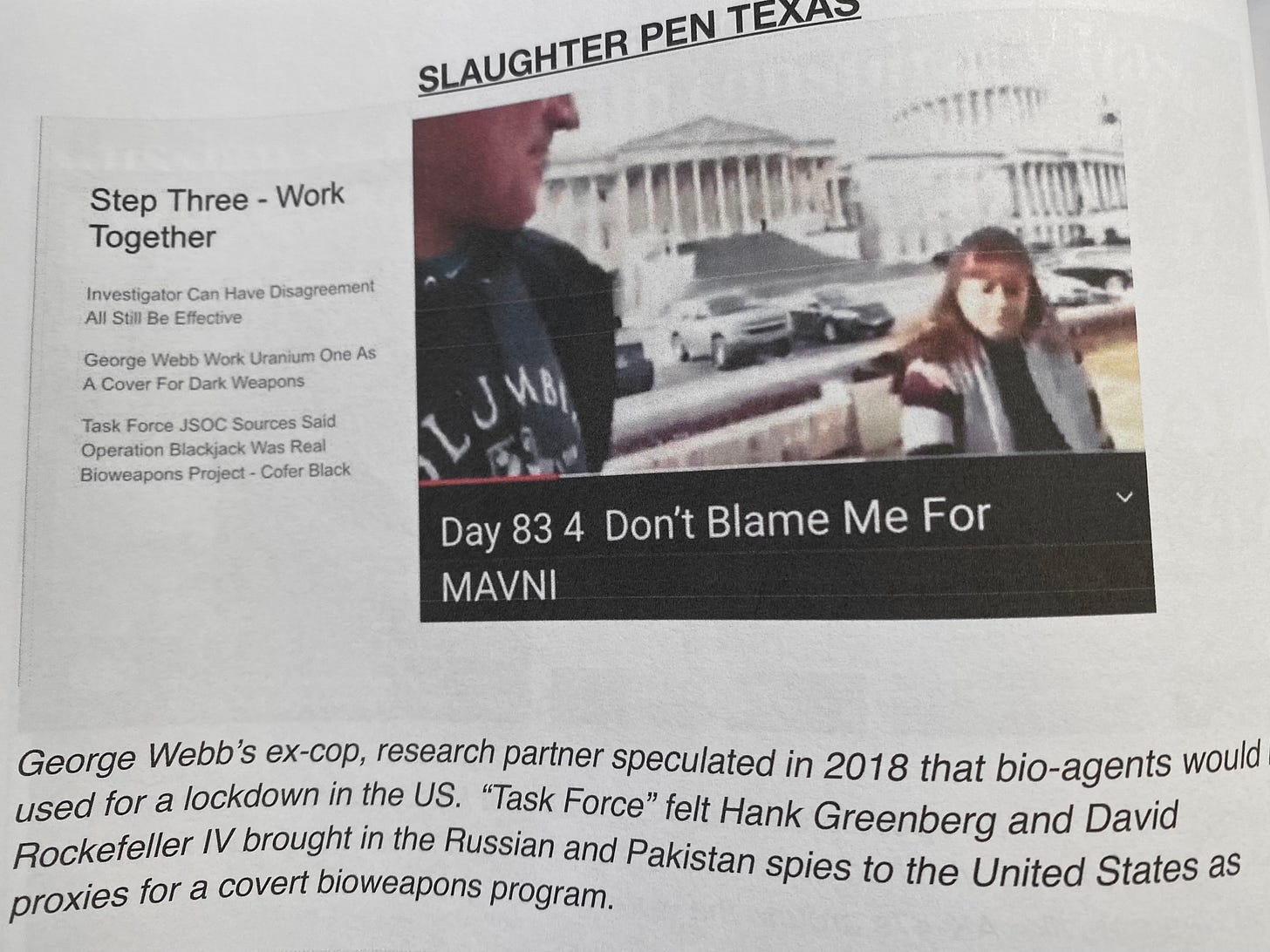
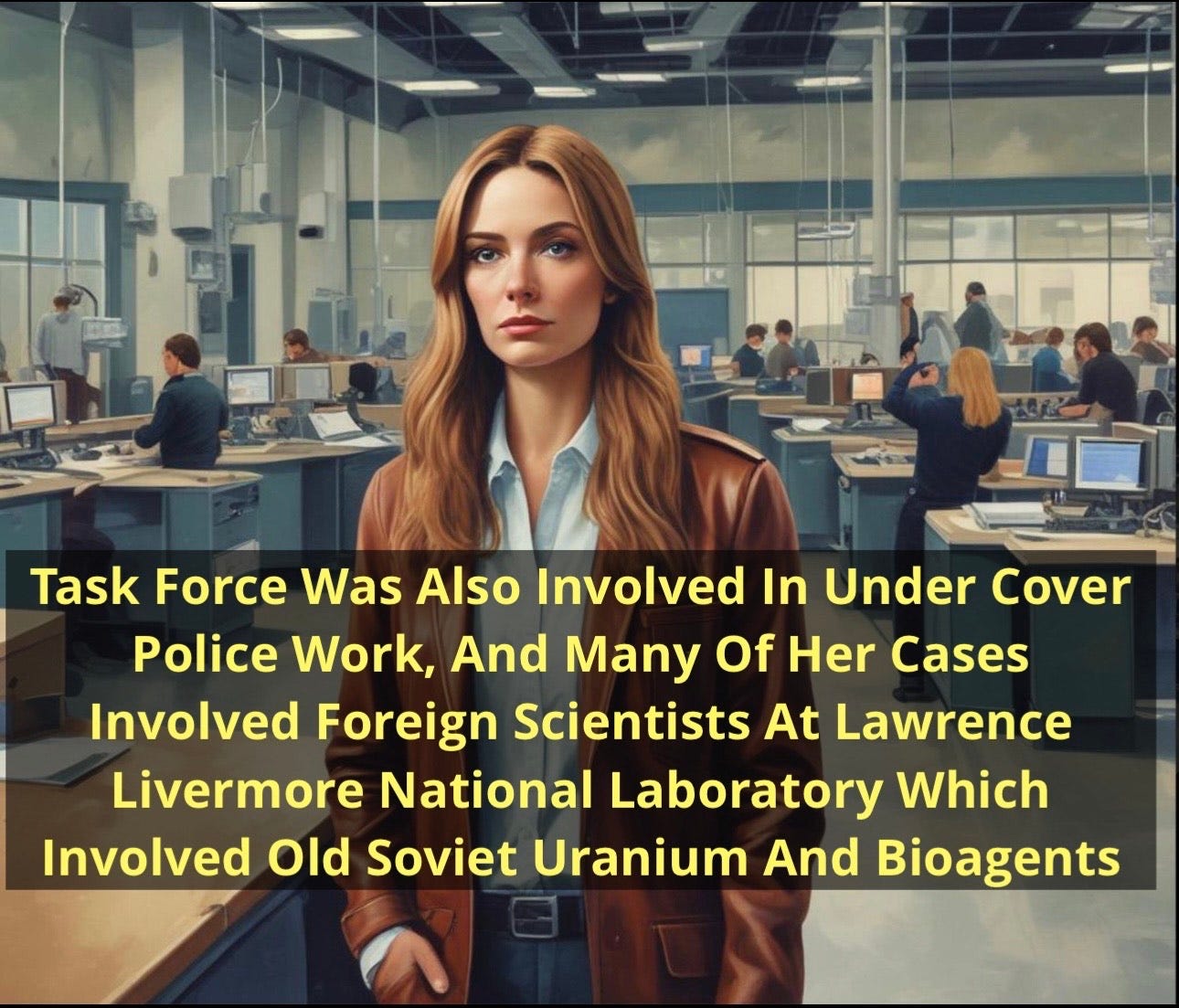

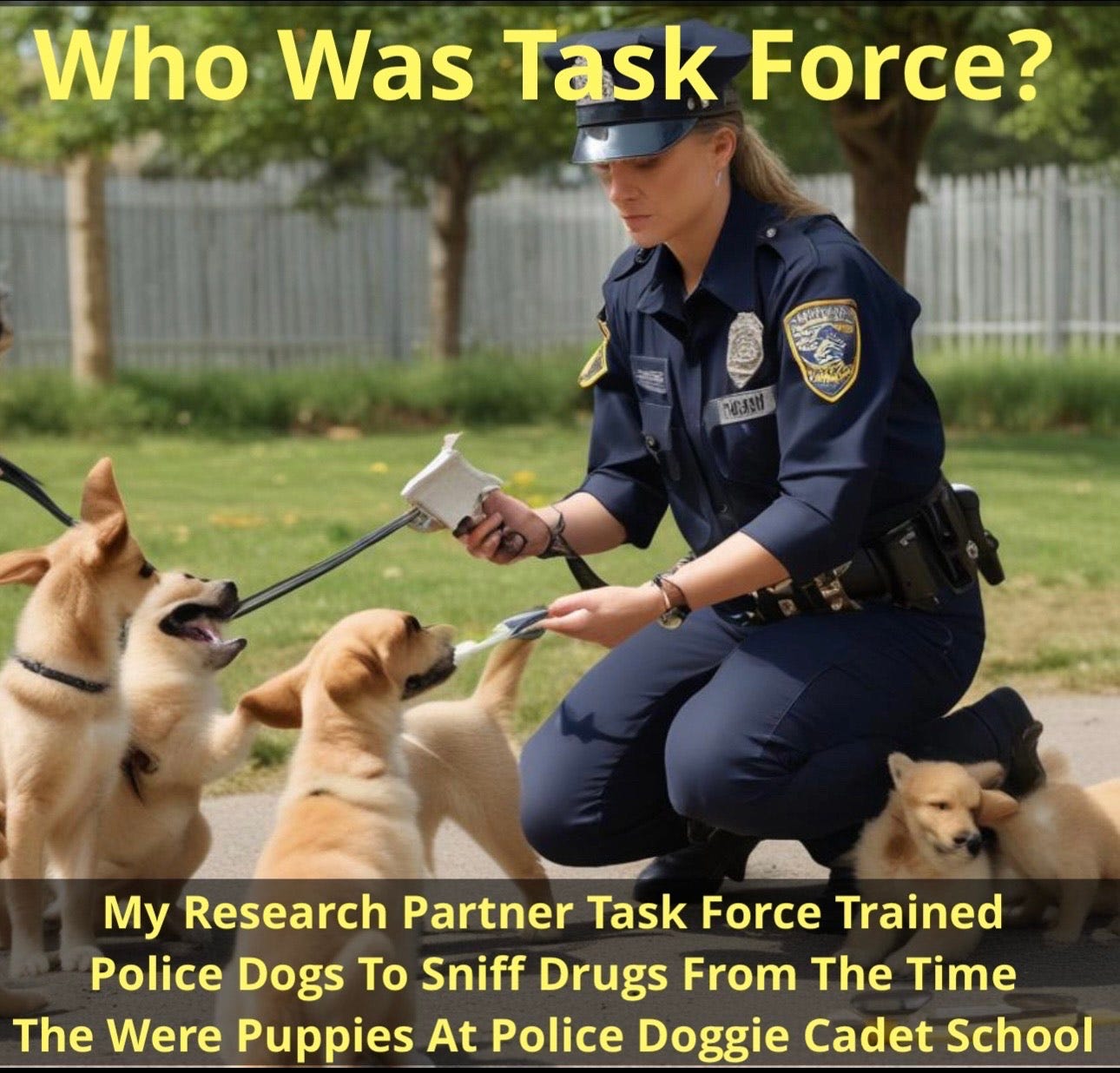






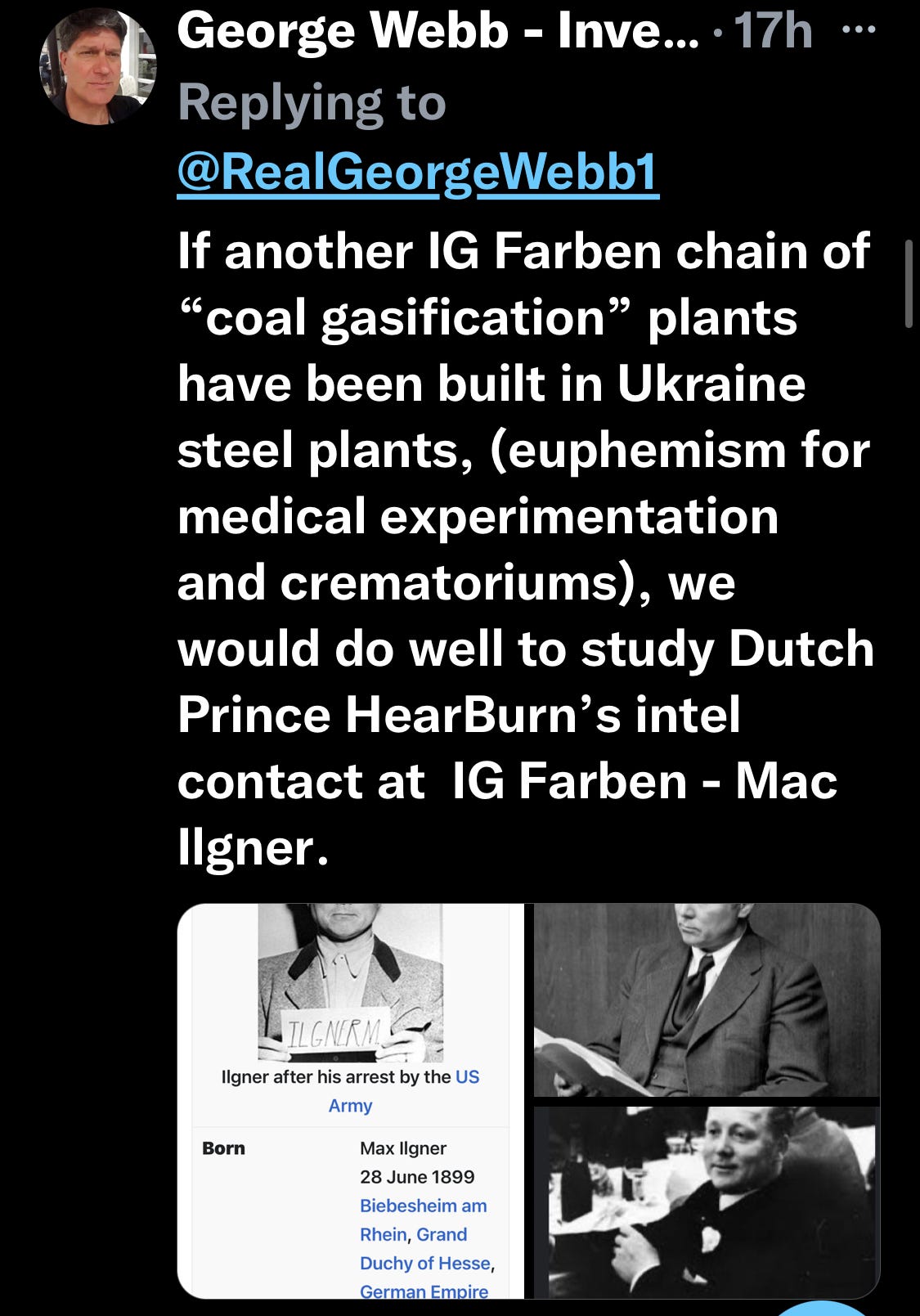
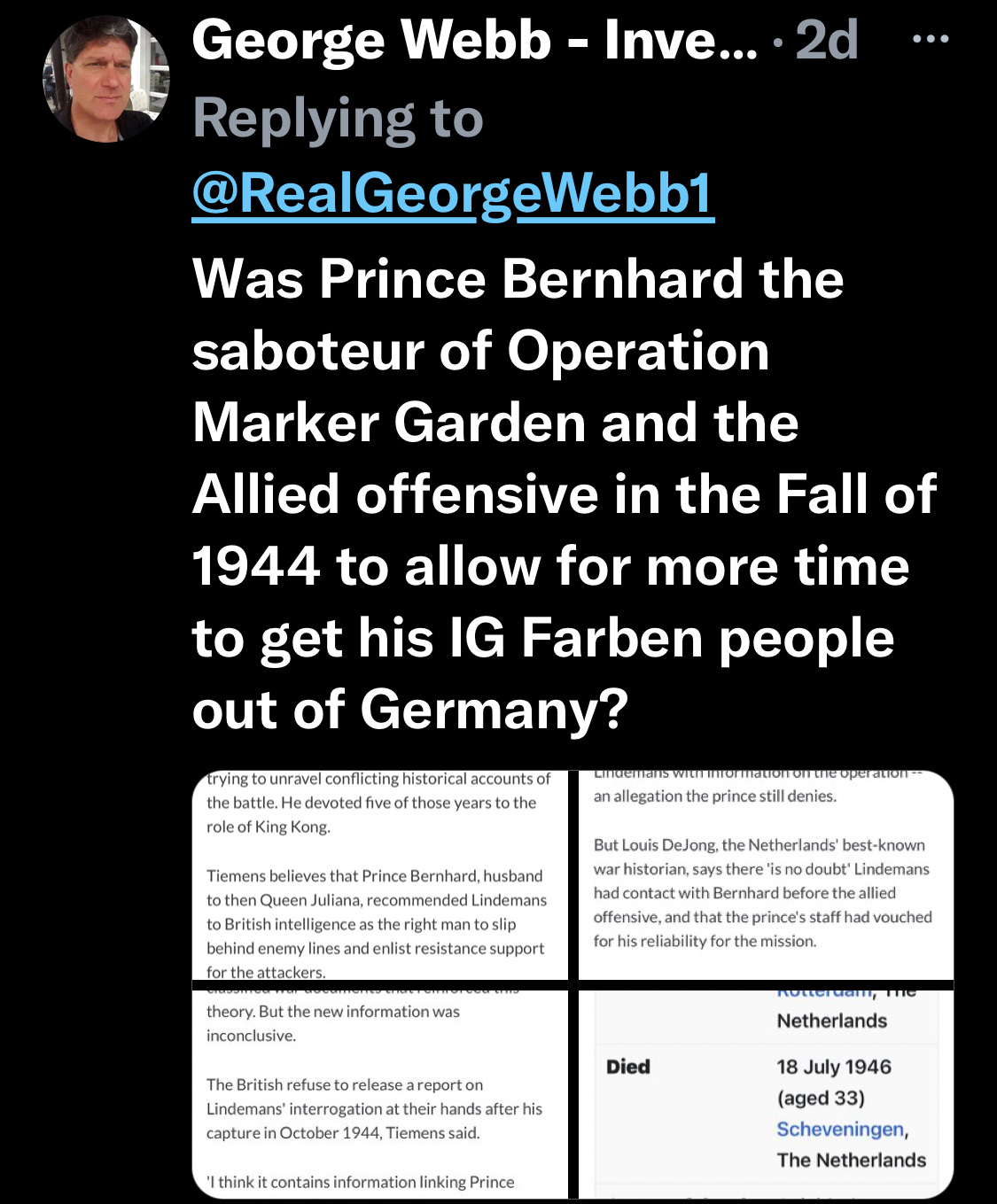
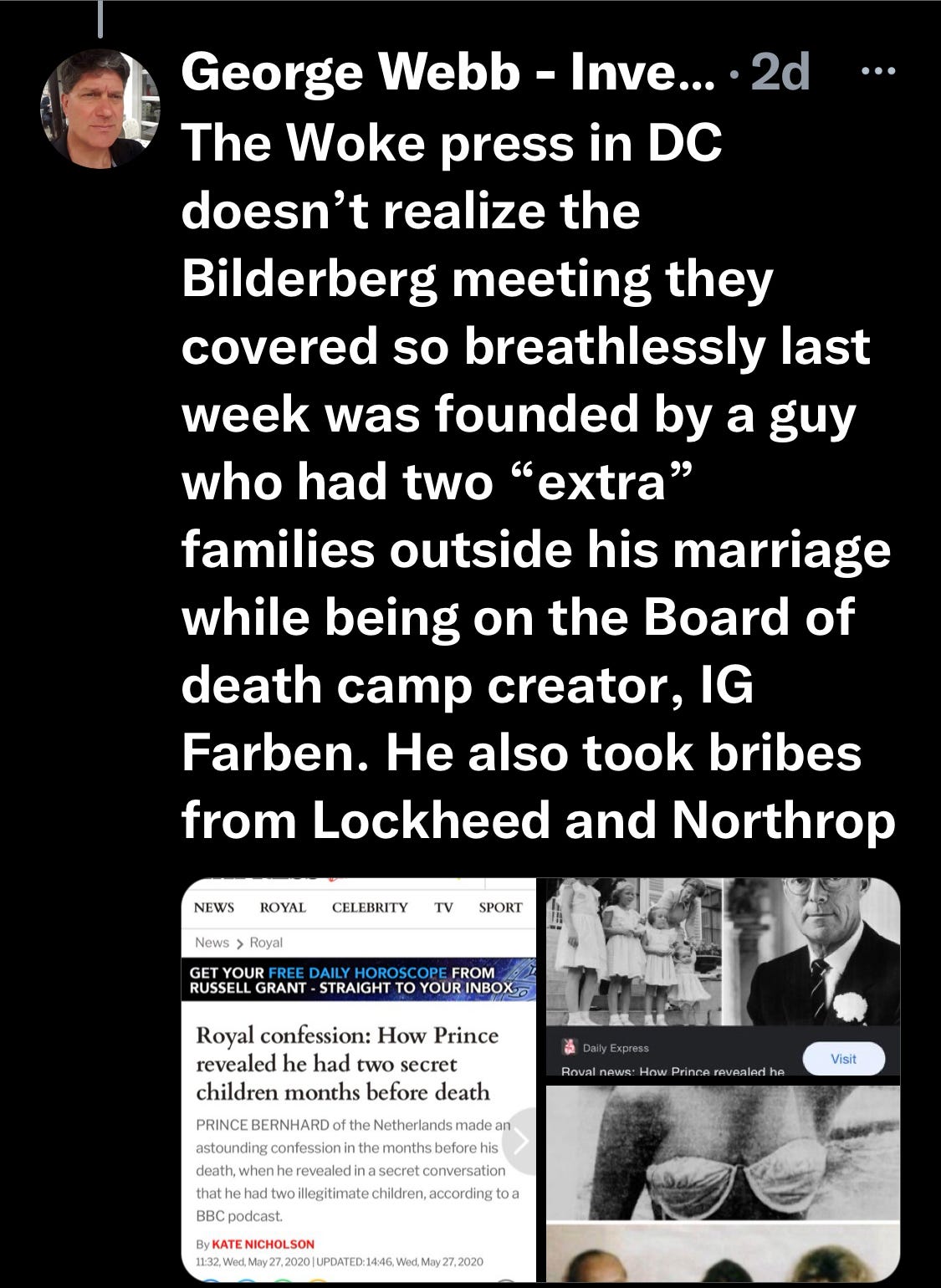
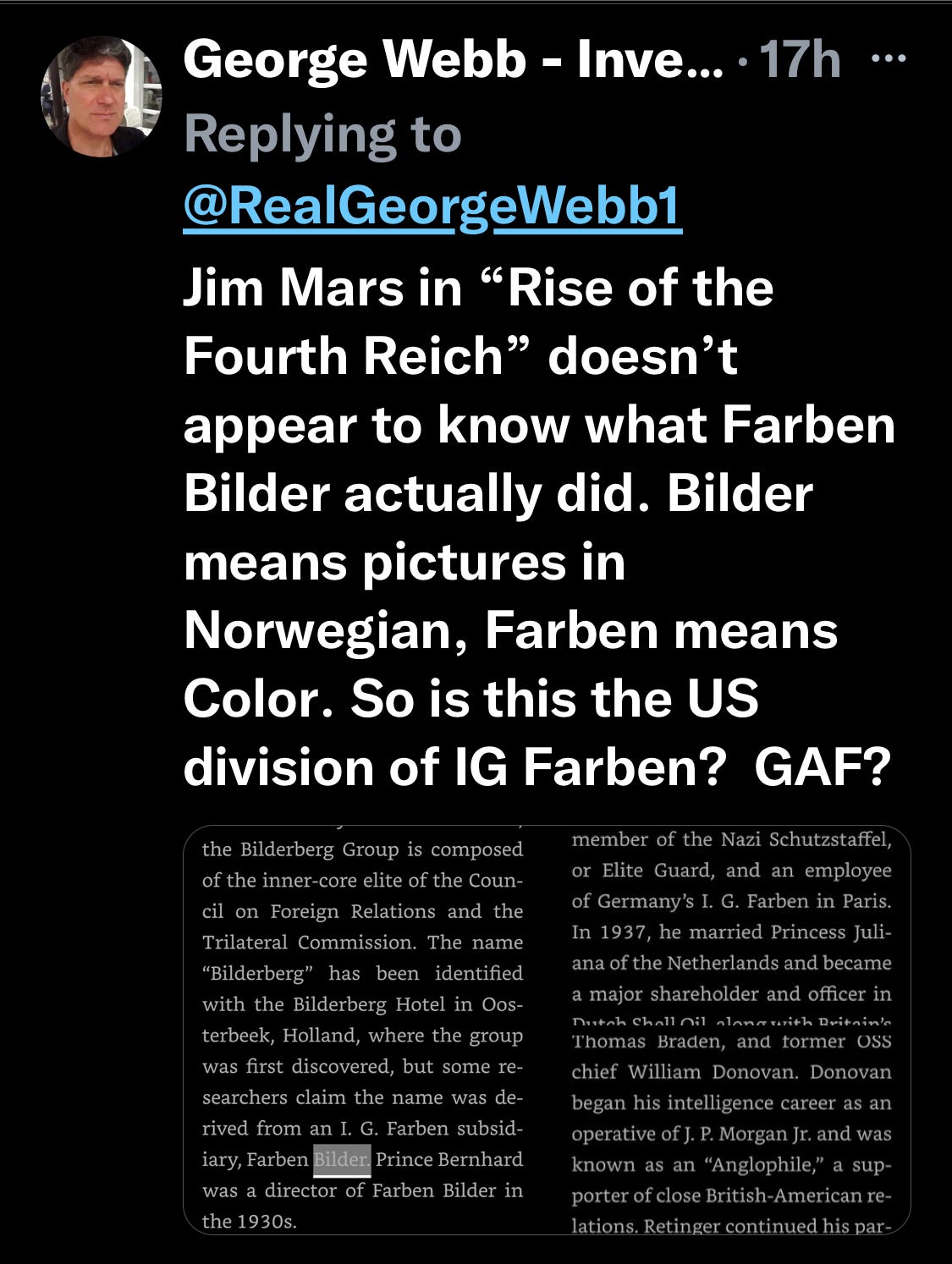
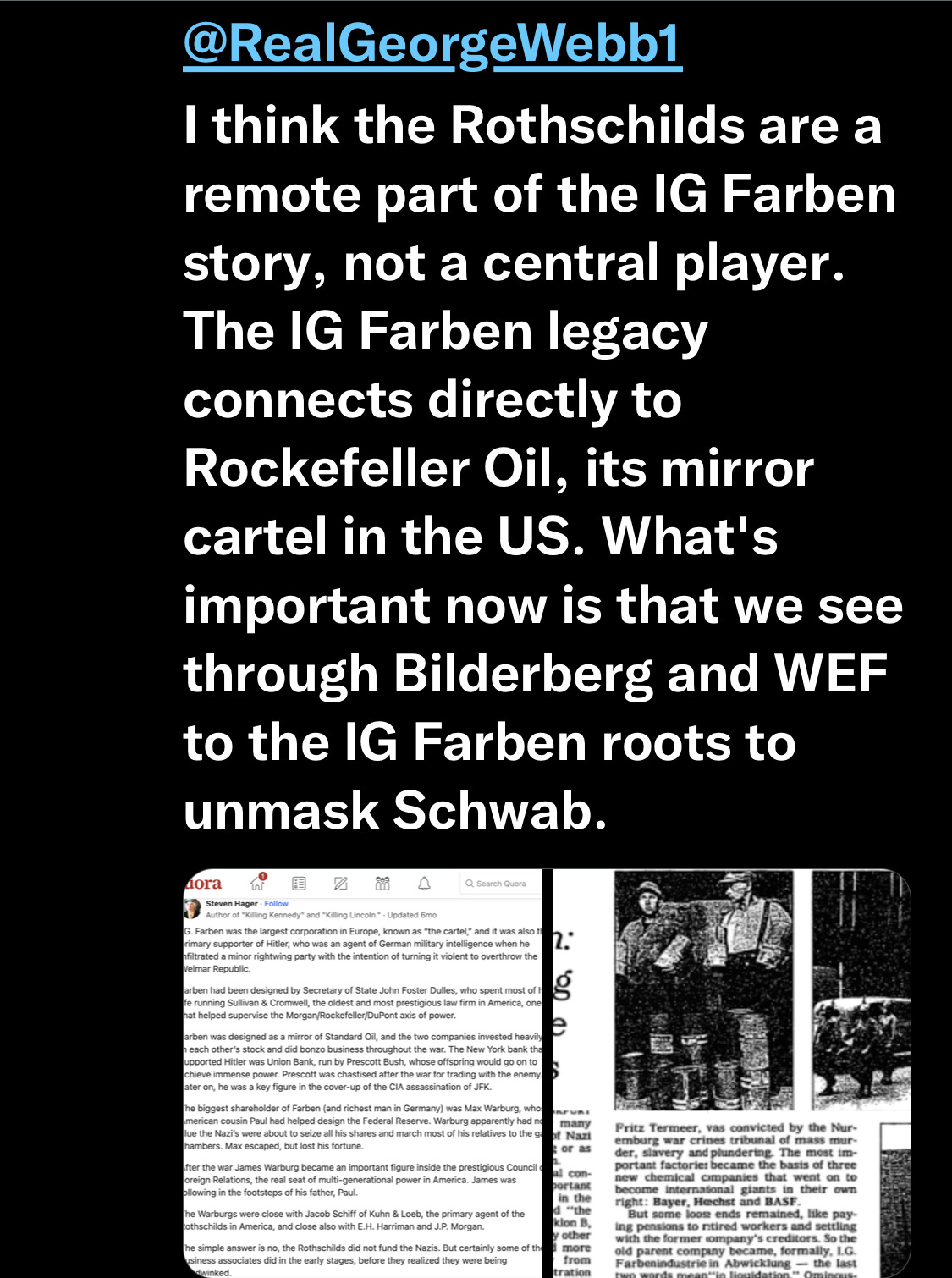
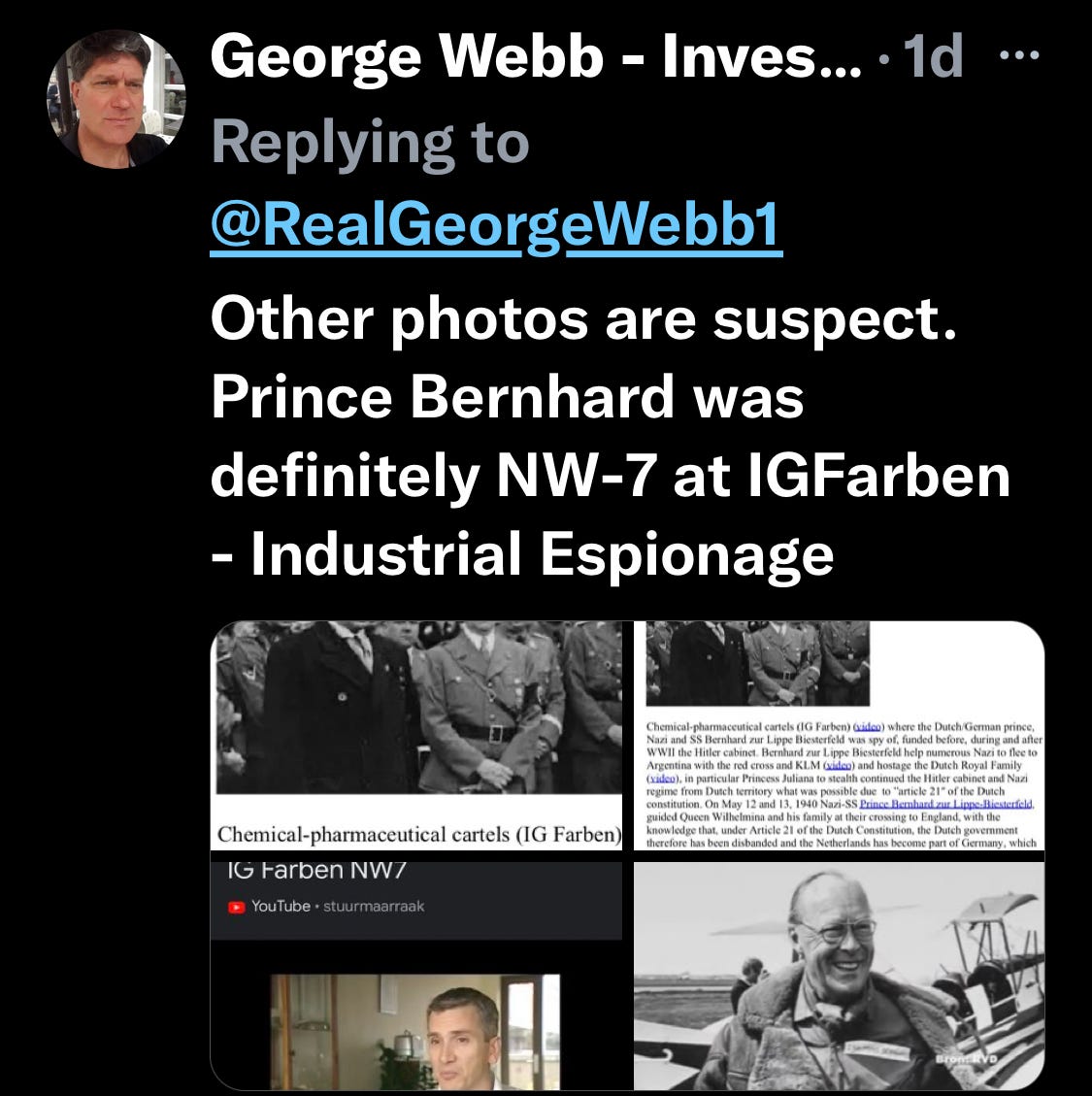
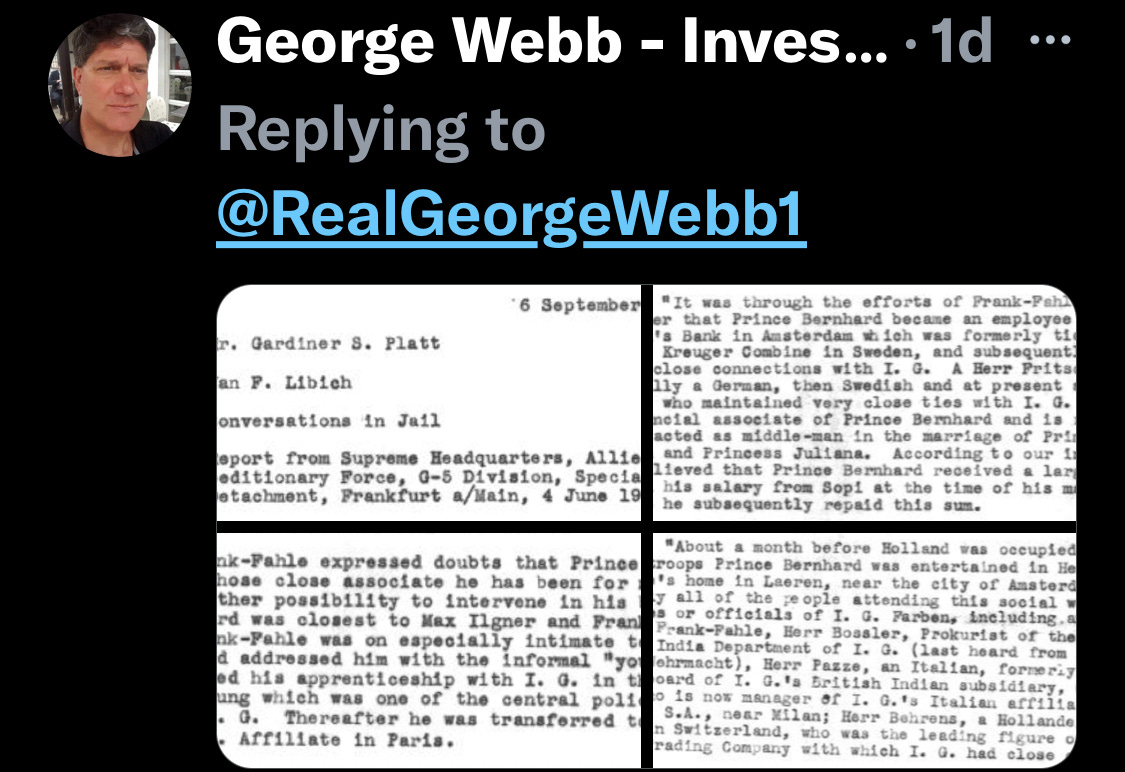
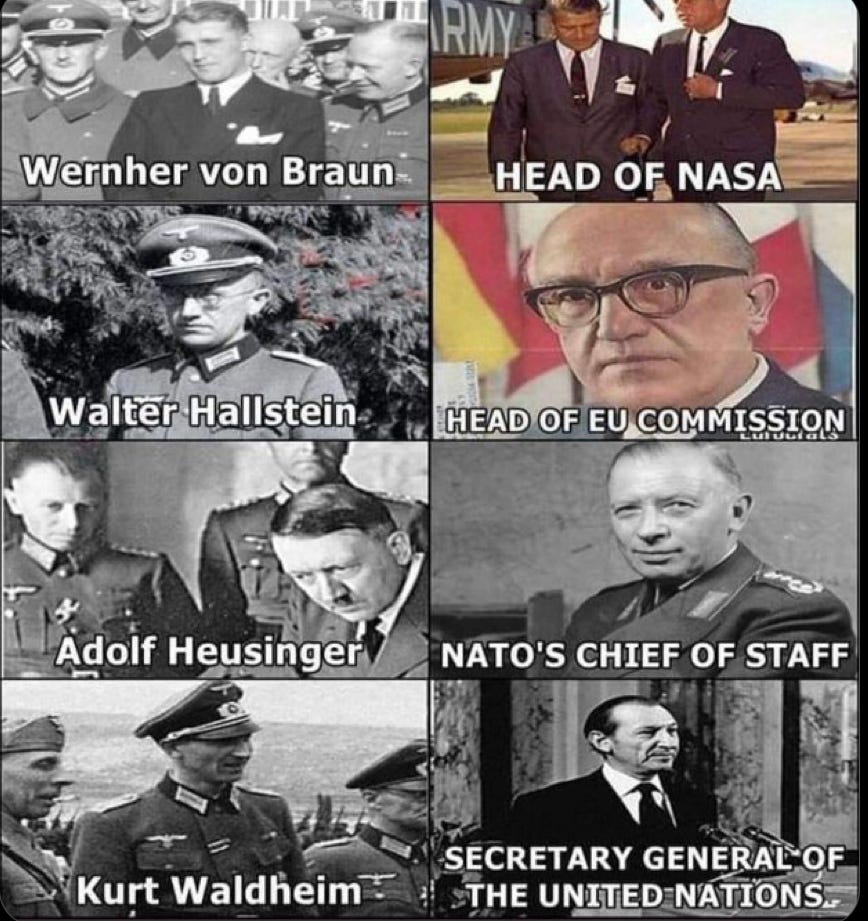
Hi there - Read Tony Gosling’s book “The Traitors of Arnhem” It takes the reader through the solid evidence that the Battle of Arnhem, Operation Market Garden, was ‘thrown’, deliberately, by senior British commanders, in order to buy the Nazis time to complete financial deals with the Allies http://www.bilderberg.org/arnhemtraitors.pdf
George you have always done great work.
How about that slaughter pen in Kansas? 10,000 cattle died at one time? Is this the next phase, airborne pathogens?